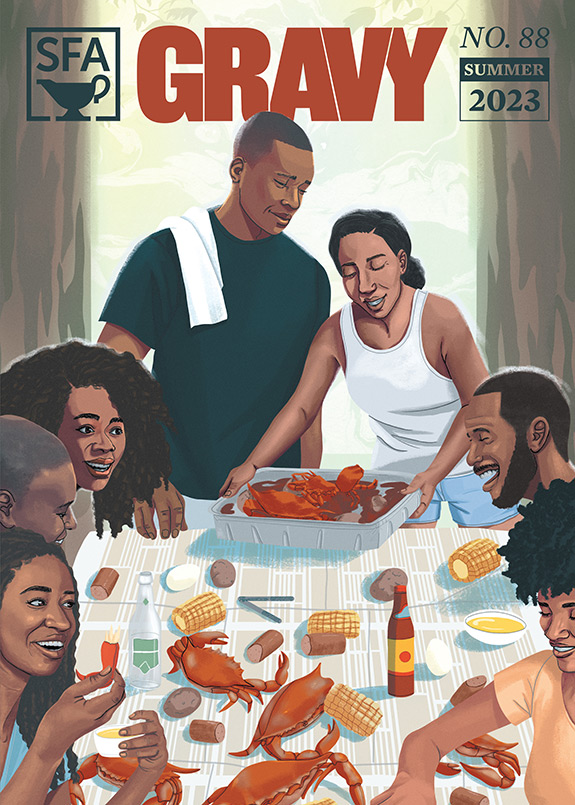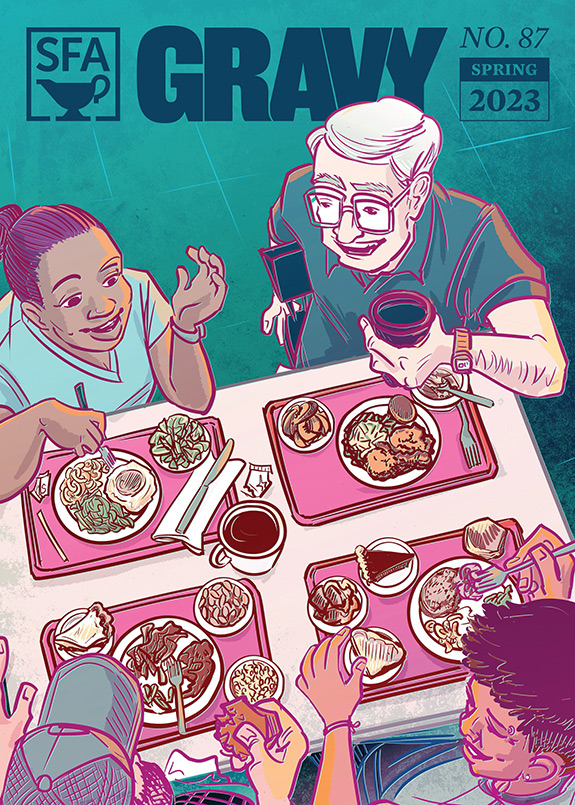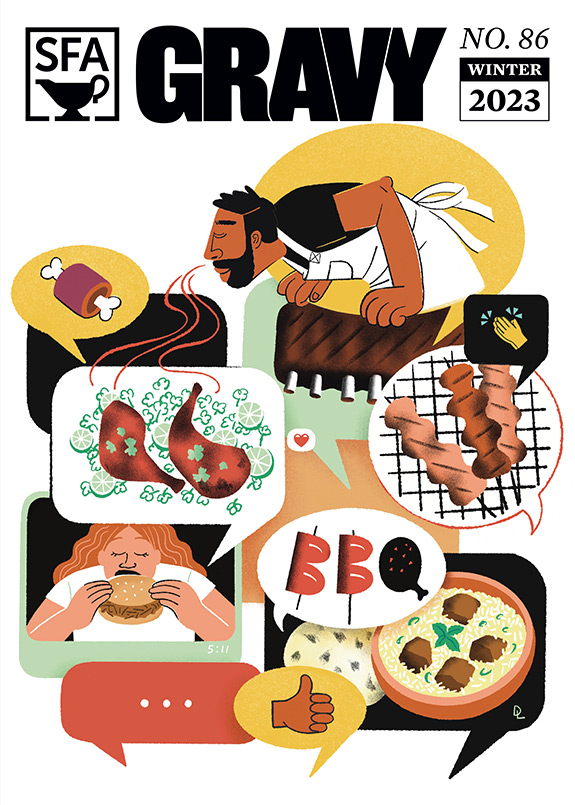
This piece by Emily Hilliard is a web-exclusive companion to our current issue of Gravy, which focuses on the foodways of Appalachia.
Helvetia, West Virginia, is not a town you can just happen upon. About 30 miles south of Buckhannon and 40 miles southwest of Elkins (you know where those are, right?), the journey to Helvetia is a long and winding mountainous route up County Route 46. Even when you get there, it would be easy to blow right through town, were it not for the Swiss Alpine–style buildings peppered along the roadside.
The village was settled in 1869 by Swiss immigrants, many of them craftsmen, who had immigrated to Brooklyn, New York, during the Civil War. In Brooklyn, they formed a society of Swiss and German speakers called the Gruetli Verein, and together sought a place where they could live freely and practice their respective art forms. One of their members had done some surveying in West Virginia and spoke of the large tracts of land, beautiful mountains, and plentiful forests of game. The group eventually found cheap land for sale in the area and decided to establish a village, calling it Helvetia, the Latin name for Switzerland.
Pride in Swiss heritage is still visible in today’s Helvetia via the hand-painted signs of coats of arms and Swiss phrases, historical markers, and preserved buildings like the Cheese Haus, Honey Haus, and Boot Maker Shop. But though well maintained, for the most part those businesses lie dormant. Being a place so isolated and small—the last census put the population at 59—Helvetia can feel like a sleepy relic on a normal day. That is, until you enter The Hütte. The town’s only restaurant, The Hütte (pronounced “hoo-tay”) is perched at the edge of town along the confluence of the Left and Right Forks of the Buckhannon River. When you step onto the long front porch and open the screen door of the bright gold gingerbread building, you get the sense that you’re entering someone’s well-loved home rather than a restaurant. The wooden floors of the dining rooms creak with age, and the walls are filled with old photographs, vintage farm tools, cloth-bound books, and other antiques. Hand-embroidered tablecloths cover the wooden tables, set with mismatched wooden chairs. In the winter, fires blaze in the wood stoves. Come summer, fresh-cut flowers serve as table centerpieces. The Hütte is cozy and quaint without being precious or contrived—it is the way it is, and has been since Eleanor Mailloux and Delores Baggerly opened it in the 1960s.
Raised in Helvetia in the 1920s, Eleanor Mailloux came back to her beloved village in the 60s after living on the Pacific island of Guam. Upon her return, she found that Helvetia had lost touch with many of its Swiss traditions, and embarked on a number of projects to help reinvigorate the town’s unique cultural heritage. Among them was Fasnacht—a Swiss Mardi Gras celebration that the town still holds annually. Mailloux also established The Hütte. She took sole ownership of the restaurant in 1976, and in her 93 years, established herself as not only the face of The Hütte—the person to greet you at the door and offer you a cup of coffee—but the matriarch of Helvetia itself.

Many of the dishes served at The Hütte came from recipes that Mailloux collected from townspeople. In 1969, the year of Helvetia’s centennial, she published a community cookbook from her findings, Oppis Guet’s vo Helvetia, or Something Good From Helvetia, which is still in print by the town’s Garden Club.
Like the cookbook and The Hütte décor, the menu also remains unchanged— and not just in the dishes offered. Though the prices have naturally risen, the cover for the physical menu is the same that appeared on tables when The Hütte first opened. On that menu there are classic Swiss items, Southern Appalachian influences, and dishes and flavors that Mailloux brought home from her travels abroad. Her daughter Heidi Arnett says, “The sausage [of veal and pork, marinated in a tomato sauce] we make is definitely from a Swiss recipe. Then my mother created some of the recipes like Morgan Henalie, a curried chicken that translates as “Morning Hen”. She created it, as well as our curried pineapple, with Asian flavors because she lived in Guam for many years and traveled to Thailand, Hong Kong, and other areas of the Far East.” The Hütte’s standard dessert is a buttery, cake-like peach cobbler spiced with nutmeg.
Alongside the listing of fare on The Hütte menu is an inscription that conveys an aspect of the restaurant that’s just as important as the food. It reads, “The Hütte is not just another restaurant, rather, it is an emotional happening.” It goes on, “Walking into the little dining room is like stepping into the warm inviting kitchen of some loved one out of the past.” As the menu notes, all of The Hütte’s furnishings and decorations were bequeathed by former Helvetia residents—there is “Grandma” Fischer’s old cupboard, Mrs. Karlen’s stove, and John Martis’ cherry brandy jug. The Hütte carries this tangible weight because it preserves items from many of the local residents, living and deceased. Betty Biggs, a Helvetia native, noted that her mother’s and sister’s embroidery work still hangs in the restaurant, and some of her own hand-carved chairs serve as guest seats.
But The Hütte is also an “emotional happening” because of the role it plays in the community, transcending its casting as a typical restaurant. Biggs shared, “Kids will be out playing, and they’ll get all hot and thirsty and go to the door and they’ll say ‘Can I have a piece of bread?’ or ‘Can I have a can of pop?’ and of course, they just give it to them, you know? And the local fishermen will be out fishing and if they don’t happen to have any fish eggs with them, they’ll stop [at The Hütte] and say, “Oh, give me some bait,” and they’ll give them some cheese or corn. And you know if you run out of something you can run to The Hütte and borrow it if they have it.”
For locals, The Hütte is a community gathering place—a neighbor with a door that’s always open for a cup of coffee and catch-up on the town news. Biggs recalls, “If you were out of electricity or whatever, you could still go down and eat. [Eleanor would] cook it on the woodstove and have the oil lamps burning and the candles going and you might end up spending the whole evening there, have a game of cards, drink some wine, play some music. It’s just that kind of place.”
The Hütte is a stronghold in the community, or as one local customer called it, the “anchor store” of Helvetia. It’s a place you can count on being open, of having the same menu items, of not changing. Many residents eat there at least once a week, sometimes more. Arnett commented, “It’s like coming home. We try not to change anything, and I think that’s what people love. If you would eat at the restaurant 20 years ago and then eat there now and then eat there 20 years from now, we hope that everything is exactly the same.”
But as much as that’s true, things inevitably change. Eleanor Mailloux passed away in 2011, leaving a huge void in the restaurant and town. At the time it was uncertain what would become of the restaurant, though many locals volunteered to step up just to keep it running. Eventually Arnett and four other family members took it over. Despite its being the main employer in Helvetia, The Hütte struggles in the winter, when tourists are sparse. The family doesn’t make money off of the business. According to Arnett, “We have [other] jobs—we don’t care about making any money, we just want to see it go. None of us make a dime from it—we’ve put everything right back into it. And we are very, very dedicated to this continuing. It certainly seems like if we can just make it through into the summer then we save a little for the winter, we can keep it going.”
Though Eleanor Mailloux’s legacy lives on in much of the town, perhaps her most lasting influence is The Hütte, which has became a symbol of Helvetia itself. It seems that one could not go on without the other. As Mailloux’s granddaughter Clara Lehmann put it, “It’s one of the only places that holds us together.” When I asked her mother was what the future held for the restaurant, she was a little more dire. “Over my dead body!” she exclaimed. Betty Biggs merely stated, “Long Live The Hütte.”
And Helvetia with it.
Emily Hilliard is a folklorist, baker, and blogger based in Washington, D.C. She blogs about pie at “Nothing in the House” and is a regular contributor to NPR’s “Kitchen Window” series.













